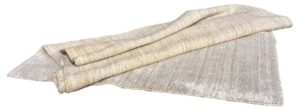Some of the most beautiful and valuable rugs on the market made from silk. They are soft to the touch, have a slight shimmer and feel absolutely luxurious. But, with all of that luxury comes a price tag that puts them out of reach for most of us.
Enter the knock off. We are familiar with “fake silk” fabrics from clothing. You would know it as Rayon. In the rug industry, this is presented as Viscose, Bamboo Silk, Banana Silk, Rayon or “Art” Silk, Tencel. These rugs are blends of “regenerative cellulose” (wood pulp fibers and cotton by products) and chemicals. Not only is the production of this textile toxic for the environment, it makes incredibly WEAK fibers. It is basically paper.
Just to give you an idea of how bad for the environment this manufacturing process is, the main byproduct is Carbon Di-sulfate – TOXIC. Production has been banned in the United States and has moved to India, China and Indonesia.
These terribly made, but beautiful viscose rugs are popular because manufactures do not disclose information about this fiber, and are not up front about the durability – telling people they are pet and child friendly, to immediately wipe up spills and simply have them professionally cleaned. Um… right… finding a professional who will clean it is a big challenge because most of us will run from that challenge.
A few other redeeming qualities about viscose:
- They are highly flammable and burn very quickly.
- Spilled water will cause a permanent stain
- They mildew very easily
- It is one of the weakest fibers on the market
- These rugs are considered disposable
Cleaning A Viscose Rug Results In Any Combination Of 4 Possible Outcomes
1) Yellowing – cellulose fibers turn yellow when wet, so any liquid that spills on viscose has the potential to turn the rug yellow. Try to clean the yellow, and you will just make it worse. Acid based detergents seem to give us the best results with very exhaustive drying attempts and variations.

2) Shedding – because the fibers making up the thread are weak and short, they break and shed. Normal wear and tear (vacuuming and walking on it) will pull lose strands and eventually make the rug look shaggy. Compare it to a sweater that pills. Washing/cleaning it just speeds up this process. You have to shave off the offending stragglers to keep the fabric looking good.
3) Bleeding – viscose just doesn’t hold dye. When you clean it, you are removing some of the dye. Usually it will fade a shade or two with each wash – and usually two washes are required to clean these rugs because one pass using a small amount of water to prevent yellowing, won’t do the job. So one pass for a half clean rug one shade lighter, or two passes for a very clean rug two shades lighter. Not great options, but better than a dirty rug.
4) Stiffening – the fibers of these fake silk rugs will never be as soft as they were before cleaning. They get hard and scratchy after cleaning. The rugs need to be misted with a softener and then hand groomed (carefully to prevent #2) during drying and again after it is fully dry.
So the short version – these rugs are 4x as difficult to clean as a quality rug, and come out looking worse despite the extra effort.
And the moral of my story is this: Buy a wool rug, buy a lower quality silk rug, buy synthetic – buy anything else. Stay away from Viscose, (Art Silk, Banana Silk, Bamboo Silk, Tencel, Rayon… fake silk.)
Request a Quote
We’ll be in contact with you shortly to give you an estimate.
